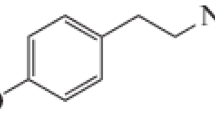Abstract
An enzyme-linked immunoabsorbent assay (ELISA) protocol was developed for the detection of small lytic peptides in transgenic grapevines (V. vinifera). The protocol requires a high concentration of protease inhibitor in the extraction buffer; the use of antiserum cross-absorbed with control tissue, an increased concentration of blocking reagents in the antiserum buffer, and performing all coating and/or binding processes at 37°C while reducing the time period for each step to 1 h. The procedure greatly reduced protein degradation, increased the signal-to-noise ratio, and it allowed the effective detection of the Shiva-1 lytic peptide (5 kDa) at concentrations as low as 0.1 μM. This procedure made it possible for routine analysis of transgene expression in Shiva-1 gene-containing transgenic grape plants.
Similar content being viewed by others
References
Arce P, Moreno M, Gutierrez M, Gebauer M, Dell’Orto P, Torres H, Acuna I, Oliger P, Venegas A, Jordana X, Kalazich J, and Holuigue L (1999) Enhanced resistance to bacterial infection byErwinia carotovora subsp.atroseptica in transgenic potato plants expressing the attacin or the cecropin SB-37 genes. Amer J Potato Res 76: 169–177.
Cary JW, Rajasekaran K, Jaynes JM, and Cleveland TE (2000) Transgenic expression of a gene encoding a synthetic antimicrobial peptide results in inhibition of fungal growth in vitro and in planta. Plant Sci 154: 171–181.
Crowther JR (1995) Methods in Molecular Biology, Vol. 42-ELISA: Theory and Practice. Humana Press, Totowa, NJ.
De Lucca AJ, Bland JM, Grimm C, Jacks TJ, Cary JW, Jaynes JM, Cleveland TE, and Walsh TJ (1998) Fungicidal properties, sterol binding, and proteolytic resistance of the synthetic peptide D4E1. Can J Microbiol 44: 514–520.
Demski JW, Bays DC, and Kahn MA (1986) Simple latex agglutination test for detecting flexuous rod-shaped viruses in forage legumes. Plant Dis 70: 777–779.
Florack D, Allefs S, Bollen R, Bosch D, Visser B, and Stiekema W (1995) Expression of giant silkmoth cecropin B genes in tobacco. Transgenic Res 4: 132–141.
Hightower R, Baden C, Penzes E, and Dunsmuir P (1994) The expression of cecropin peptide in transgenic tobacco does not confer resistance toPseudomonas syringae pvtabaci. Plant Cell Rep 13: 295–299.
Jaynes JM (1993) Use of genes encoding novel lytic peptides and proteins that enhance microbial disease resistance in plants. Acta Hort 336: 33–39.
Koenig R and Paul HL (1982) Variants of ELISA in plant virus diagnosis. J Violo Methods 5: 113–125.
Kumpatla SP, Chandrasekharan MB, Lyer LM, Li G, and Hall TC (1998) Genome introder scanning and modulation systems and transgene silencing. Trends Plant Sci 3: 97–104.
Li Z, Jayasankar S, and Gray DJ (2001) Expression of a bifunctional green fluorescent protein (GFP) fusion marker under the control of three constitutive promoters and enhanced derivatives in transgenic grape (Vitis vinifera). Plant Sci 160: 877–887.
Mourgues F, Brisset MN, and Chevreau E (1998) Activity of different antibacterial peptides on Erwinia amylovora growth, and evaluation of the phytotoxicity and stability of cecropins. Plant Sci 139: 83–91.
Owens LD and Heutte TM (1997) A single amino acid substitution in the antimicrobial defense protein cecropin B is associated with diminished degradation by leaf intercellular fluid. MPMI 10: 525–528.
Reynoird JP, Mourgues F, Norelli J, Aldwinckle HS, Brisset MN, and Chevreau E (1999) First evidence for improved resistance to fire blight in transgenic pear expressing the attacin E gene fromHyalophora cecropia. Plant Sci 149: 23–31.
Sambrook J, Fritsch E, and Maniatis T (1989) Molecular cloning: A laboratory manual. Cold Spring Harbor Laboratory Press, New York, USA.
Sharma A, Sharma R, Imamura M, Yamakawa M, and Machii H (2000) Transgenic expression of cecropin B, an antibacterial peptide fromBombyx mori, confers enhanced resistance to bacterial leaf blight in rice. FEBS lett. 484: 7–11.
Tijssen P (1985) Practice and theory of enzyme immunoassay. Elsevier Sci Publishers BV, New York, pp. 344–350.
Author information
Authors and Affiliations
Corresponding author
Rights and permissions
About this article
Cite this article
Li, Z., Jayasankar, S. & Gray, D.J. An improved enzyme-linked immunoabsorbent assay protocol for the detection of small lytic peptides in transgenic grapevines (Vitis vinifera). Plant Mol Biol Rep 19, 341–351 (2001). https://doi.org/10.1007/BF02772832
Published:
Issue Date:
DOI: https://doi.org/10.1007/BF02772832




